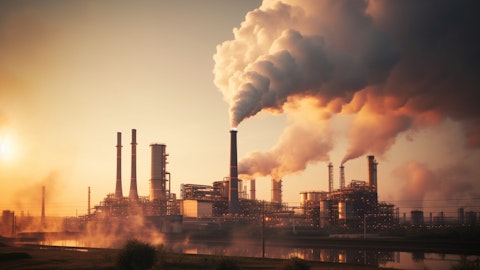LSB Industries, Inc. (NYSE:LXU) Q2 2025 Earnings Call Transcript July 30, 2025
Operator: Greetings, and welcome to the LSB Industries Second Quarter 2025 Earnings Conference Call. [Operator Instructions] As a reminder, this conference is being recorded. It is now my pleasure to introduce your host, Kristy Carver, Senior Vice President and Treasurer. Thank you. You may begin.
Kristy D. Carver: Good morning, everyone. Joining me today are Mark Behrman, our Chairman and Chief Executive Officer; Cheryl Maguire, our Chief Financial Officer; and Damien Renwick, our Chief Commercial Officer. Please note that today’s call includes forward-looking statements. These statements are based on the company’s current intent, expectations and projections. They are not guarantees of future performance and a variety of factors could cause the actual results to differ materially. For more information about the risks and uncertainties that could cause actual results to differ materially from those projected or implied by forward-looking statements, please see the risk factors set forth in the company’s most recent annual report Form 10.
On the call today, we will reference non-GAAP results. Please see the press release posted yesterday in the Investors section of our website, lsbindustries.com, for further information regarding forward-looking statements and reconciliations of non-GAAP results to GAAP results. At this time, I’d like to turn the call over to Mark.
Mark T. Behrman: Thank you, Kristy, and good morning, everyone. Page 4 of our presentation summarizes highlights from the second quarter. Sales volumes increased 6% year-over-year driven by solid improvement in sales volumes of AN and UAN. These gains are the result of higher ammonia production and better performance by our upgrading plans. We’re pleased that our efforts to improve the reliability and efficiency of our facilities are yielding results, and we expect to make further progress in the second half of 2025. We achieved our increase in production and sales volumes during the second quarter while having 0 recordable injuries across the organization. I want to congratulate our entire team for embracing our Protect What Matters core value and demonstrating that Goal Zero is achievable.
Lastly, we continue to focus on our allocation of capital. And during the quarter, we not only invested in supporting the growth and improvement in our business, but we bought back $32 million of debt. Cheryl will provide a few more details on our leverage. Now I’ll turn the call over to Damien to review current market dynamics and pricing trends. Damien?
Damien J. Renwick: Thanks, Mark, and good morning, everyone. Turning to Page 5, demand for our industrial products remains robust. We continue to ramp up our ammonium nitrate solution volumes as we expand our industrial business. Copper and gold mining activity remained strong with pricing for both near all-time highs. We continue making progress optimizing our sales mix, targeting 1/3 of our sales under cost-plus contracts, further neutralizing the volatility of natural gas and fertilizer price swings. To achieve this mix shift, in early July, we began transitioning our sales of HDAN, a spot price fertilizer product to ANS used in industrial and mining applications. We expect to wrap up our production of HDAN later in the third quarter.
We believe this shift will improve stability and predictability in our financial performance. Nitric acid demand remains strong, supported by the resilience of the U.S. economy. In addition, we believe that the proposed countervailing duties on Chinese imports of MDI, a polyurethane feedstock could drive the favorable structural change in the domestic MDI market leading to higher nitric acid demand. On Page 6, we continue to see strong prices for our fertilizer products. The Spring 2025 planting season resulted in strong demand and pricing for nitrogen fertilizers. This was due in part to the expected increase in planted corn acres, driven by continued low corn stocks-to-use ratios. The USDA estimates U.S. producers planted 95.2 million acres of corn this year compared to 90.6 million planted acres last year.

UAN prices are up significantly from a year ago. The current NOLA UAN price of $350 per ton is more than 70% higher than this time last year. The Tampa ammonia price for August is $487 per ton, slightly above year ago levels. This increase reflects reduced supply from the Middle East, North Africa and Russia and higher European production costs. Tight global supply is expected to continue in the short term. Now I’ll turn the call over to Cheryl to discuss our second quarter financial results and our outlook. Cheryl?
Cheryl A. Maguire: Thanks, Damien, and good morning. On Page 7, you’ll see a summary of our second quarter 2025 financial results. You can see the early benefits of our investments in plant reliability and efficiency through increased net sales and stronger volumes. Page 8 bridges our second quarter 2024 adjusted EBITDA of $42 million to our second quarter 2025 adjusted EBITDA of $38 million. Higher pricing for UAN, higher sales volumes and a reduction in our fixed plant costs were offset by materially higher natural gas costs. Page 9 provides a summary of our key balance sheet and cash flow metrics. Our cash balance remains strong. During the quarter, we repurchased approximately $32 million of our Senior Secured Notes and additionally, we have an equipment loan coming due in August and we will reduce debt by an additional $5 million in the third quarter.
Our second quarter 2025 CapEx reflects investments in ANS loading and storage capabilities at our El Dorado facility. This will enable us to meet the strong demand for the product that Damien mentioned earlier. We will continue to make investments in the reliability of our facilities while also investing in storage and logistics capabilities to support our growing industrial business. Turning to the third quarter outlook. The Tampa ammonia price settled at $487 for August, an increase of $70 a ton over July’s price and NOLA UAN is currently trading around $350 per ton. Our natural gas costs have averaged approximately $3.25 per MMBtu quarter-to-date, higher than our average gas cost of $2.40 in the third quarter of last year. However, we expect third quarter gas prices to be less of a headwind to our year-over-year comparison relative to what we experienced in the first half of 2025 based on pricing we are seeing thus far in the third quarter.
From a volume perspective, we continue to expect meaningful increases in both UAN and AN sales volumes compared to prior year. This will result in lower sales volumes of ammonia as we forgo ammonia sales in favor of upgrading into higher-margin products. Collectively, we expect these favorable dynamics to result in a healthy year-over-year increase in adjusted EBITDA as compared to the third quarter of last year. And now I’ll turn it back over to Mark.
Mark T. Behrman: Thank you, Cheryl. Page 10 is an overview of the low carbon project at El Dorado. Our partner, Lapis Carbon Solutions completed the drilling of a stratigraphic injection well in June. Lapis continues to gather data from this well to support the EPA in its continuing technical review of our Class VI permit application with technical review expected to be complete in the first quarter of next year. We are expecting to use the same well for our CO2 injections when in operation. We continue to expect to begin CO2 injections by the end of next year. We were pleased with the progress that we made in the first half of 2025 towards meeting our goals for the full year. We continue to generate increasing ammonia, UAN and AN volumes and we achieved higher sales volumes of our higher-margin products.
We’re successfully shifting our sales mix to an increasing percentage of contractual industrial sales, which enables us to pass through our natural gas costs and provides us with a more stable base of earnings with multiyear visibility. As I mentioned at the start, our safety performance was excellent with 0 recordable incidents so far this year, and we expect that to continue. Lastly, we reduced our debt further and maintained a healthy liquidity position while continuing to invest in plant reliability and strategic projects. I am enthusiastic about our prospects for the remainder of the year and look forward to our continued progress of improving our business and generating improved financial results. Before we open it up for questions, I’d like to mention that we will be participating in the following events in the coming months, the Jefferies Industrial Conference in New York on September 3 and the UBS Global Materials Conference also in New York on September 4.
We look forward to seeing some of you at those events. That concludes our prepared remarks, and we will now be happy to take your questions. Thank you.
Q&A Session
Follow Lsb Industries Inc. (NYSE:LXU)
Follow Lsb Industries Inc. (NYSE:LXU)
Receive real-time insider trading and news alerts
Operator: [Operator Instructions] Our first question comes from Lucas Beaumont with UBS.
Lucas Charles Beaumont: Just wanted to start on UAN. So the first half volumes were up sort of about 30,000 tons year-on-year. Coming into the year, you were looking to kind of potentially lift volumes up to 150,000 tons initially. How do you see sort of the outlook there for the second half now in terms of the size of the growth that you think you can generate? And what are you kind of doing to maximize that and capitalize on the really strong relative UAN pricing that we’re seeing at the moment?
Mark T. Behrman: So we — as you probably remember, we did an expansion of our UAN production back in September of last year, up at our prior facility. And while we’re getting the maximum rates that we expected, we’re still working out some kinks to do it consistently. So I think we’re pleased that the plant itself operates at the higher rate and it’s been fairly consistent, but we’re still working on that. So I think we have expectations that the second half of the year should have higher UAN production out of that facility and then therefore, higher sales. Remember, though, we do have seasonality that we’ll have to deal with, right, the first half of the year. Usually, you’re going to see more products sold in the second half of the year.
Lucas Charles Beaumont: Great. And then I just wanted to ask about the setup for the third quarter. So I mean, typically, that has a lot more sort of industrial sort of mix, less ag mix and it’s usually sort of the smallest quarter for the year seasonally. Just this year, though, we’ve sort of got some diversion dynamics compared to normal. So UAN pricing has been really strong. It’s continued to increase into July. Ammonia pricing has sort of been stable and you should sort of get sort of also some volume uplift. So I mean it seems to me the combination of those factors could have EBITDA potentially even like flat sequentially on the second quarter or at least seeing a much less of a decline than you would normally get. How are you guys kind of thinking about things there?
Mark T. Behrman: I think you’re spot on.
Operator: Our next question comes from Andrew Wong with RBC Capital Markets.
Andrew D. Wong: So we’ve seen an improvement in production and operating rates now, and I think you’re pretty far down the path for operational improvements, which is great. Maybe can you just talk about more like on the cost side of things as those operating rates stabilize, where do you see costs trending over time? And I think there are some costs that are tied to the improvement programs as well like contractors and consultants and things like that. So as those required costs kind of fall off, like what can we expect on the overall cost side?
Mark T. Behrman: So first off, yes, we’ve made a lot of improvements on the operational side, but we still have a lot of initiatives going on that we believe can still add significant EBITDA to — annual EBITDA to where we are today, right? I mean, the goal for ammonia plants is 95% consistently, right? Reliability is really key. The goal for our upgrading plants is, generally speaking, improved from where we are today. So I do think we still have some significant improvement that we can make that should translate into a meaningful increase in EBITDA. On the cost side, I’m going to turn it over to Cheryl. We have a lot of initiatives going on because we are now focused on not only just pulling costs out, but really creating efficiencies throughout the business that by themselves will create cost decreases.
Cheryl A. Maguire: Andrew, we had said coming into this year that we would expect our costs to reach an inflection point in 2025 and then start trending down from there. In addition to that, we talked about $15 million to $20 million of cost reduction through efficiencies as Mark just mentioned. So we should be — we’re starting to work on that now. I think by the end of the year, we’ll probably be, I would say, 25% complete towards the $15 million to $20 million target that we’re looking for. So we’ll see the balance of that come out across ’26 and maybe a bit into ’27.
Mark T. Behrman: And I would say one thing to add to that. Keep in mind that when you make some changes now, we’re not going to see the annualized benefit obviously until next year. So while we pull — we’re working on those initiatives today, we’ll probably be able to report at the end of the year what the annualized effect is going into 2026.
Andrew D. Wong: Okay. Got it. That makes sense. And yes, obviously, I appreciate there are still certain levers you can pull to improve operating rates here. And then just going on to the tariffs, what’s your sense on impact from tariffs on U.S. nitrogen prices so far this year versus just how tight the market was with the demand and some of the supply issues? And then just as you touched on in your prepared remarks, with the onshoring on some of the industrial businesses, that’s definitely impacted demand domestically. Can you just talk about what that might mean for pricing and margins for LSB, if you can help quantify it, that would be great or in any way you can?
Mark T. Behrman: Damien, do you want to answer that?
Damien J. Renwick: So in terms of the tariffs, I think it’s honestly been a little hard to discern some of the impacts given some of the more pertinent market dynamics around supply and also being in the peak season of demand. But I think from a urea perspective, there’s been, I think, some impact for the other products, probably not so much. Going forward, I think we’re closely monitoring what happens with Russia, if there’s any sort of tariff there and then any adjacent tariffs for other countries doing business with Russia. That’s likely to have a more meaningful impact on nitrogen. So we’re closely monitoring that. In terms of the onshoring of production here in the U.S., look, that’s going to have a long runway until we start seeing anything material.
I think in the in the shorter term, there are opportunities for the U.S. domestic market to take advantage of the current environment. We’re seeing that a little bit with copper at the moment, right, like the support for U.S. copper domestically is in producers like Freeport and others, really focus on driving their efforts there and exploring with some priority expansion activities there. So I think that’s certainly a tailwind for us and something that we’re looking forward to seeing realized in the future.
Mark T. Behrman: I would add on to that, that those activities make us really look at some potential debottlenecking or expansion because they underpin some of those expansions.
Operator: Our next question comes from Laurence Alexander with Jefferies.
Unidentified Analyst: This is Kevin on for Laurence. I guess my first one has to do with fertilizer prices. They’ve been pretty elevated like UAN. And I guess there’s been some deterioration of farmer economics and that’s, I think, largely because of lower corn prices. Are you seeing any signs of demand destruction, let’s say, as of July from the farmer perspective of UAN?
Mark T. Behrman: Yes. Kevin, really through — as we got through Spring season, we really didn’t see much demand destruction at all, but moving through to fill, I think given where prices are, there’s certainly some hesitancy from a retailer’s perspective to buy. But I think that’s really been consistent with what we’ve seen for the last 3 or 4 years. So it’s probably more the new normal that we’re seeing. And we’re in a comfortable position coming out of Spring with our inventory, and we’re comfortable with where our forward sales are sitting. So — but we’re monitoring it. Corn prices, we’d like to see it a little higher and that would help support farmer economics. But you might see a bit of an impact on the edges in that marginal corn plantings for next year. So yes, and I think the USDA is already sort of indicating some of that in its outlook.
Damien J. Renwick: I think one thing that could possibly help corn prices. So we just negotiated a deal with the EU for them to purchase a lot of energy as part of that. I think the hope is that we’ll see some ethanol being exported over to Europe, which will increase demand for ethanol and in turn demand for corn. So again, I think that plus there’s the continued conversation going from E10 to E15 and gasoline could support some more demand from the ethanol industry and then supporting demand for corn.
Unidentified Analyst: Okay. Great. And my second question, so I asked about this on last quarter’s call on the administration’s deregulation push. I guess I was wondering whether or not your views have changed on, let’s say, over the last 3 months and basically how big of a tailwind it could or could not be? Have you noticed any substantial changes yet like in terms of permitting, for example?
Mark T. Behrman: Well, we’ve seen much more dialogue with the federal agencies, particularly the EPA and then state agencies that — maybe we’re a little hesitant given the actions of the EPA and the government — the federal government oversight. I think both state agencies and federal agencies have been more user-friendly. And so that’s actually helped us in some of our conversations just on environmental conversations at the sites and with projects, things like that.
Operator: [Operator Instructions] Our next question comes from Rob McGuire with Granite Research.
Robert Miles McGuire: Mark, UAN, can you kind of tell us what you’re seeing in terms of UAN import trends? And do you have any comments on the June, July Ukrainian strikes on the Russian fertilizer plants? Has there been any discussion about how that’s impacting Russian export volumes?
Mark T. Behrman: Damien, do you want to take that?
Damien J. Renwick: Rob, so in terms of the import trend this year, fertilizer year imports for UAN were below last year. And I think that contributed to some of the tightness that we saw overall in the market. In terms of the drone strikes, et cetera, we haven’t seen any immediate impact just yet and maybe that’s because of where we’re at seasonally transitioning into the next year and the fill period. And of course, there’s still been no fill programs announced in the market. So that is an indication of how well balanced or comfortable the producers are at this stage. But it’s clearly something that we’re monitoring, but I think the bigger factor will be those tariffs that I talked about earlier. That’s something that will have a more material impact going forward.
Mark T. Behrman: And I also think — don’t you think that the European tariffs on Russia as they gain some momentum and of course, the tariff rates and amounts go up, will have a huge impact.
Damien J. Renwick: Yes, it will certainly see a redistribution of global trade routes for UAN. So I think it will just see a shuffling. You might see some pricing impact as freight rates are impacted on the global trade. But yes, we’ve yet to see any immediate impact from that.
Robert Miles McGuire: And then totally different topic, Leidos. Any changes with Leidos at this point in time that you could share with us, the lawsuit?
Mark T. Behrman: No. We are at least currently scheduled to go to trial, start the trial in late October, subject to our judiciary system making any changes.
Operator: [Operator Instructions]
Mark T. Behrman: Great. Well, hearing no other questions. I want to thank everyone for participating on our Q2 earnings call and your interest in LSB Industries. Thanks.
Operator: This concludes today’s teleconference. You may disconnect your lines at this time. Thank you for your participation.
Follow Lsb Industries Inc. (NYSE:LXU)
Follow Lsb Industries Inc. (NYSE:LXU)
Receive real-time insider trading and news alerts





